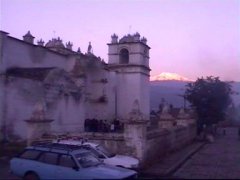 Continuation of "A TRANSLATION MEMOIR: 45 YEARS WITH CESAR VALLEJO"
Continuation of "A TRANSLATION MEMOIR: 45 YEARS WITH CESAR VALLEJO"Dr. Clayton Eshleman
While Barcia and I were working on the Spanish Civil War poems, I showed him the 1968 translation of Human Poems, which he carefully went over, penciling in the margins around 2000 queries and suggestions for changes. He felt that what I had accomplished was meaningful but that we could do a better job working together. We worked from roughly 1972 to 1977 (other than during the year that Caryl and I were in France), and the University of California Press brought out Cesar Vallejo: The Complete Posthumous Poetry in 1978. This volume included what had previously been called Human Poems along with Spain, Take this Cup from Me.
There were some good scholarly reasons for a retranslation. In 1968, an expensive weighty tome billed as the Obra Poetica Completa appeared, published by Francisco Moncloa Editores in Lima which besides typeset pages offered facsimile reproductions of the hand-corrected typescripts for all but several of the poems Vallejo wrote in Europe between 1923 and 1938. The presence of the facsimilies enabled Vallejo’s old friend and at that time his most dedicated scholar, the poet Juan Larrea, to establish a rational order for nearly half of these poems, which are undated. It also seemed clear at this time that Vallejo himself had not chosen the title Poemas humanos and that its choice was the work of his widow. Larrea believed that the undated poems and prose poems were a book in themselves and that Vallejohad planned to call them Nomina de huesos, based on a poem with that title. He also proposed that a coherent title for the dated poems could be Sermon de la barbarie), based on a key phrase in the final poem of that collection. The existence of the Moncloa edition enabled Barcia and me not only to base our translation on Vallejo’s own worksheets but to build a section of notes based on the neologisms, intentionally misspelled words, and handwritten changes that Vallejo made on the typescript. I was persuaded by both Barcia and Larrea to divide the old Human Poems up into two collections called Payroll of Bones and Sermon on Barbarism.
In 1988 I arranged with Paragon House in NYC to bring out a selection of my translations of poets who could be thought of as “conductors of the pit,” conducting the abyss, as it were, and not the symphony. Conductors of the Pit included selections from Rimbaud, Vallejo, Cesaire, Artaud, and Holan. When making the Vallejo selection, I got involved, once again, in revising previous versions, this time the ones that Barcia and I had done together. Some of these changes today strike me as less effective than the Eshleman/Barcia translations they were based on. But I understand my dilemma: given the contextual looseness of Vallejo’s European poetry, there are often multiple denotative word choices, and at one time choice X is going to look better than choice Y.
Up to this point, all of my translational attention to Vallejo had been confined to the European poetry. However, I had been circling around his second book, Trilce (1922), for many years, realizing in the 1960s and 70s that since it was a much more difficult book to translate than the poetry of his that I was struggling with, I should leave it alone. By the late 1980s, I decided that if I could work with a Peruvian then a translation of Trilce could be attempted, so I teamed up with Julio Ortega (one of the few Peruvian writers in Lima in the 1960s who did not think I was a spy!), and we decided to do it together. We worked out a first draft of the book in the fall of 1989. Caryl and I moved to Boston for a month, and every morning I took a bus into Providence, and climbed the hill to Julio’s office where we would work for several hours. Once back in Michigan, I went over our work and realized that I had questions often about several words in a single line. While Julio would occasionally respond to my queries, it was clear by the end of 1990 that he had decided that I should finish Trilce on my own. And by then I needed his, or someone’s help, even more than I had needed it in the beginning. There are still many words in this book that have gone uncommented upon in Vallejo scholarship (or have been wildly guessed at), and while critics can generalize and address Vallejo in terms of themes and preoccupations, a translator must go at him word by word, revealing all of his choices in English without being able to dodge words. This is especially true in the case of Trilce, with possibly coined, Arcane, archaic, or obscure words.
| <<Page 5 | >>Page 7 | ||||||||||||||||||||||||||||||||||||||||||||||||||||||||||||||||||||||||||||||||||||||||||||||||||||||||||||||||||||||||||||||||||||||||||||||||||||||